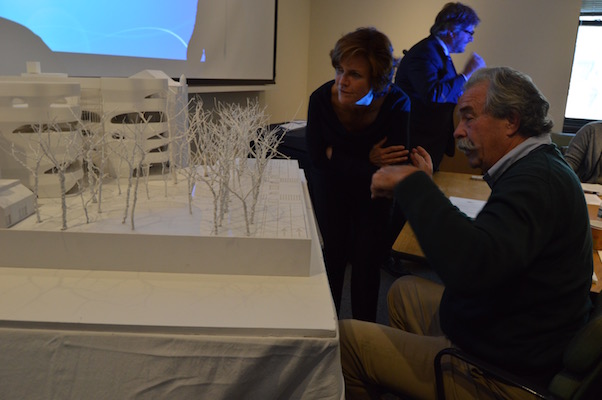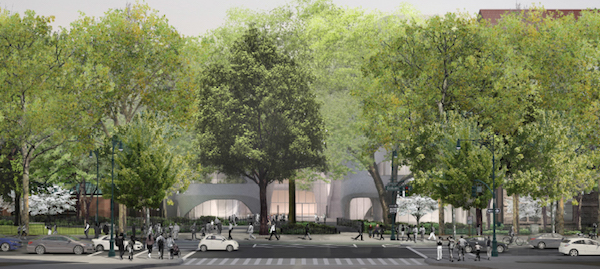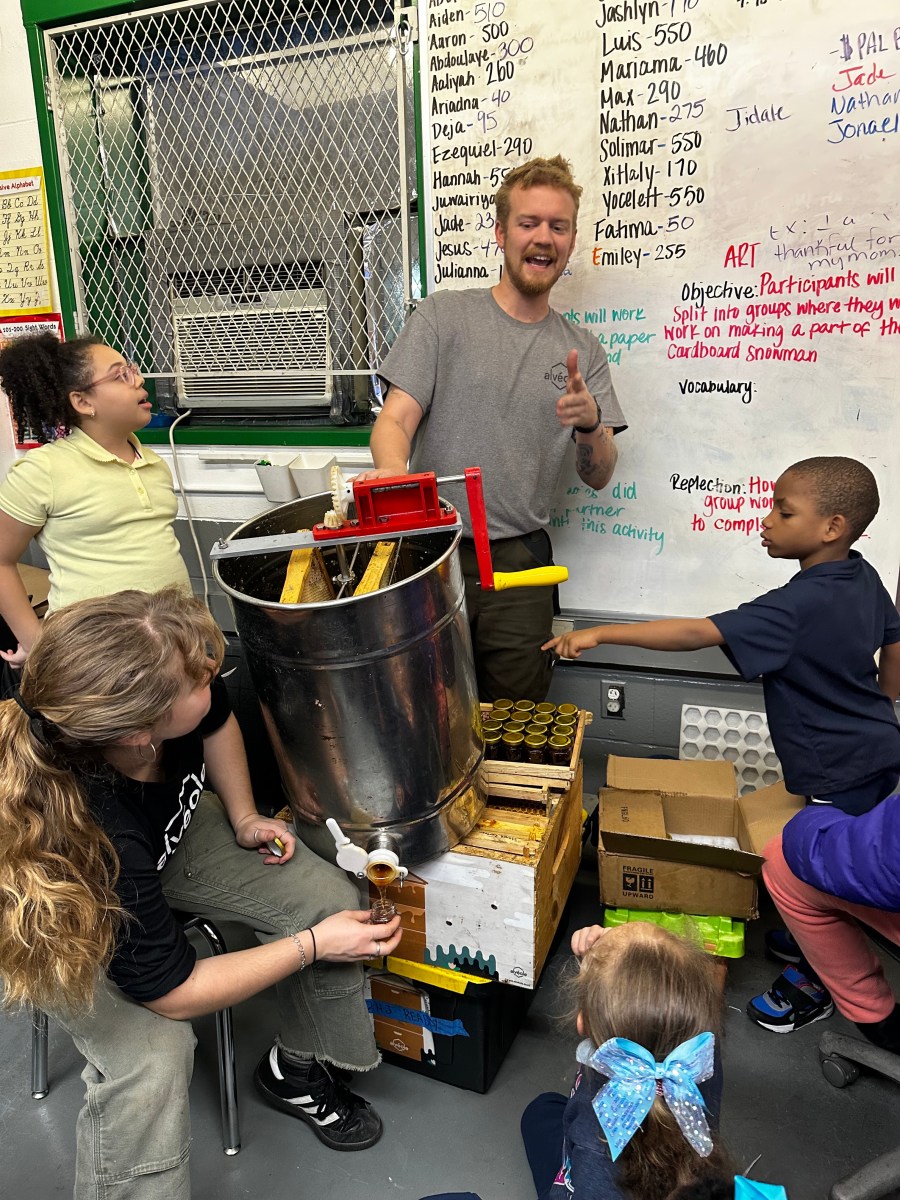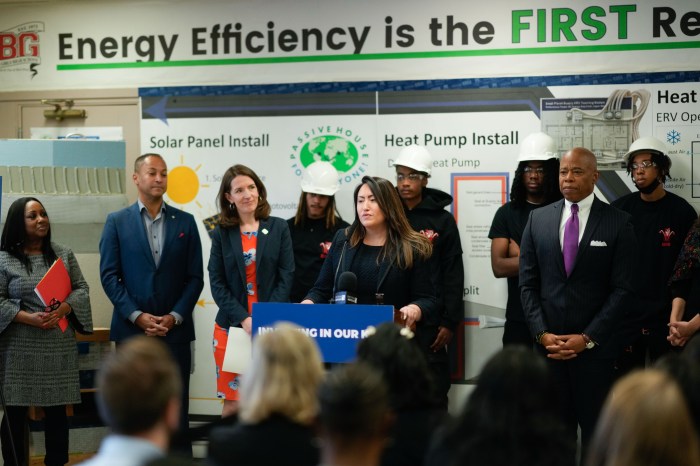
BY JACKSON CHEN | The American Museum of Natural History’s controversial expansion project on Columbus Avenue won unanimous approval from the Landmarks Preservation Commission on October 11. The commissioners’ vote followed Community Board 7’s majority approval six days earlier.
The museum’s Richard Gilder Center for Science, Education, and Innovation has the goal of offering more programmatic space while also alleviating interior visitor flow within the museum. The $325 million project has bumped into strong and continued opposition from residents due to its encroachment on the surrounding Theodore Roosevelt Park and the building’s “out-of-character” scale, according to those against it.
In July, the museum responded to those concerns by unveiling a redesign of the park that included a wider entrance, quiet areas designed for neighborhood use, and the preservation of two notable mature trees.
In one of the first steps in its review process, the project went before the LPC because of the demolition of three existing buildings and the creation of the Gilder Center within a museum campus that is landmarked. The commissioners praised the project design, calling it a “beautiful contemporary expression” and a “stunning piece of architecture.”

“I think it’s going to be a wonderful addition to one of the best institutions in the world,” LPC Chair Meenakshi Srinivasan said. “I think the commission can very proud in approving a project like this… it goes way beyond the appropriateness.”
Many of the commissioners took turns commending the design from Jeanne Gang and her team at Studio Gang.
“There’s the very compelling design, this cavernous extra-tall space experience, which I think is just so powerful and really captured the imagination of lots of people in the community,” LPC Commissioner Adi Shamir-Baron said.
The only suggestion the commission offered was its questioning of the use of stucco for the rear façade of the structure, which would be visible from the interior courtyard of the museum. As for the main façade of the Gilder Center, the project’s design team said they would employ the same material, Milford pink granite, used by the Theodore Roosevelt Memorial Hall on the other side of the museum.
“The museum has been working with the architect to make sure the project respects the existing museum campus and its location in a landmark district and in a public park,” Ellen Futter, the museum’s president, said in a written statement. “We appreciate the careful consideration of the Landmarks Preservation Commission and we look forward to the next steps in the process.”
Like the LPC, CB7 signaled its embrace of both the museum’s expansion and the park’s redesign with a full board vote on October 5.
“The most difficult question for me is the loss of a quarter acre of park land in favor of a quarter acre of building,” Klari Neuwelt, CB7’s Parks Committee chair said. “I do think, on balance, that the plusses of the design, both the park and new building, outweigh the negatives of removing a quarter acre of park space.”
CB7 member Richard Asche noted that the board’s purview that night was to consider the specifics of the museum’s proposed expansion design and the park improvements, and to leave the bigger debate about the overall project for when the environmental impact statement is completed.
“It is too bad we’re not allowed to consider all these issues as a whole,” Asche said. “As for the building itself, I think it’s going to enhance the 79th Street corridor… As to the park, the design looks okay. The question is whether the mitigation is adequate, and that we’ll consider when we do an EIS.”
During testimony from community members, teachers spoke of the educational value their students would gain from the museum’s expansion, and Columbus Avenue business owners said they would prosper from the extra foot traffic generated by a new museum entrance.
However, the opposition filled the room and presented CB7 with sheets filled with thousands of signatures that requested Mayor Bill de Blasio’s intervention, according to Claudia DiSalvo, president of Community United to Protect Theodore Roosevelt Park.
William Raudenbush, a member of Community United, said the Gilder Center project would set a precedent for future expansion of the museum at the cost of park land.
“We all cherish green space, it’s so quietly rejuvenating,” Raudenbush said. “And they’re not making any more of it. They’re making plenty more museum buildings and plenty more developments, but they’re not giving back park land.”
While some board members noted the impressive number of signatures, the full board ultimately deemed the designs appropriate in a 37 to 1 vote, with three abstentions.
“The museum is deeply grateful for the careful and extensive review that Community Board 7 has given our proposal,” Ellen Futter, the museum’s president, said in a written statement. “Community input has played an important role in this project, and we are delighted that the Community Board, along with numerous neighborhood organizations, has offered this strong endorsement.”
The full board’s approval followed on CB7’s Parks and Preservation Committees’ votes on September 20. Despite criticism from the public, the committees forged a consensus in support of the museum’s plans while recommending that it investigate ways to separate museum visitors from park users and to achieve a zero carbon footprint for the expansion.
With sweeping approvals so far, the museum will now focus on its draft environmental impact statement that will bring the project in front of CB7 again in 2017.


































